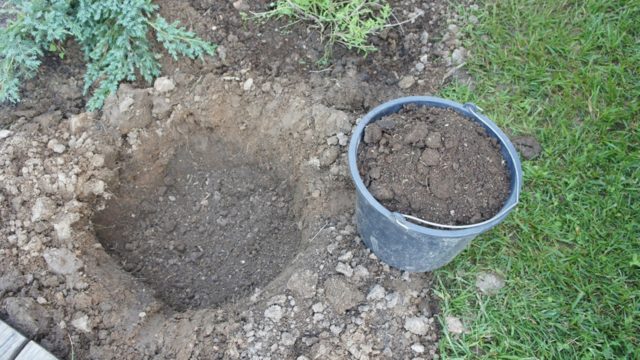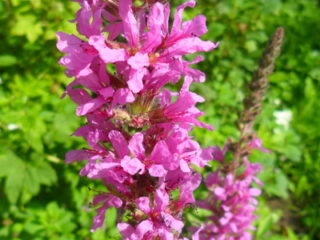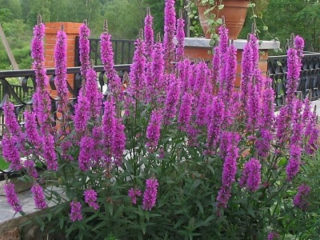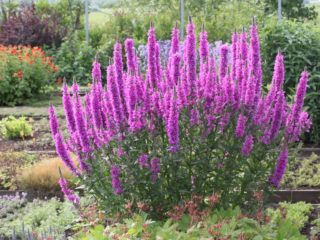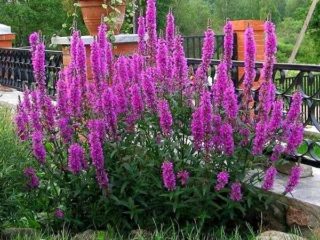Content [скрыть]
Loosestrife Blush is one of the most beautiful types of culture, which is widely used in single and group plantings in landscape design. The main advantage of the plant is its ability to adapt to any climatic conditions and at the same time delight with its flowering. The popular name for the loosestrife is plakun-grass, since at high humidity, droplets of water appear on its tops of the shoots.
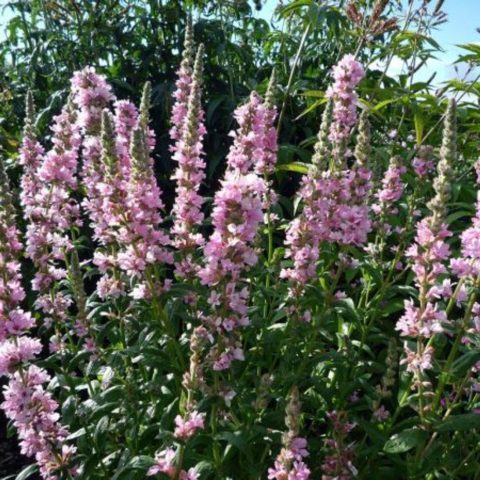
Blush's loosestrife can grow in one place for several decades.
Description of Willow Loose Blush
This variety, like other perennial species, is a herbaceous plant. The loosestrife Lythrum Salicaria Blush forms large bushes, the height of which reaches 150 cm. In the presence of favorable conditions for growth, the perennial expands to 1.5 m in diameter.
The root system of the plant is superficial, branched. The processes are large, fleshy, which lignify with age. Restoration points are located at the top of the root. From them every spring a loose rosette grows, consisting of numerous shoots.
The stems of Blush's loosestrife are tough, tetrahedral. Leaves are lanceolate, about 7-8 cm long. Their surface is slightly pubescent. The shade of the plates is green, but with the arrival of autumn they acquire a crimson tone. In the lower part of the shoots, the leaves are located opposite, and in the upper part - alternately.
The flowers of Blush's loosestrife are small, stellate, up to 1.5-2.0 cm in diameter. They are collected in dense spike-shaped inflorescences located in the axils of the bracts. The petals have a beautiful pale pink hue, which fully justifies the name of the variety.
The blooming period of the Blush loosestrife begins in the second half of June and lasts until the end of August. The plant exudes a pleasant aroma and is an excellent honey plant.
The fruits of Blush's loosestrife are an oblong oval-shaped box. It contains seeds that can be used for sowing.
This variety has high frost resistance. He does not suffer from a drop in temperature to -34 degrees. Therefore, in regions with a temperate climate, the Blash loosestrider does not require shelter for the winter.

The decorativeness of the plant decreases with a lack of moisture in the soil.
Application in landscape design
The plant can be used to decorate flower beds, mixborders and framing ponds. This variety also looks good in the form of single plantings against the background of a green lawn. And the conifers in the background will be able to emphasize its beauty.
Best neighbors for him:
- geranium;
- iris and marsh gladiolus;
- serpentine mountaineer;
- loosestrife;
- daylilies;
- phlox;
- rudbeckia;
- host;
- astilba;
- dicenter;
- yarrow;
- crocosmia;
- miscanthus.

Derbennik Blash is notable for its versatility in landscape design
Breeding features
This variety can be propagated by seeds, dividing the bush and cuttings. The first method is more laborious, so it is inferior in popularity to the other two. The seeds of the plant can be planted in open ground before winter.
It is recommended to divide the bush in the fall after flowering or in early spring at the very beginning of the growing season. To do this, you need to dig up the plant and cut it into 2-3 parts with a shovel.It is quite difficult for one to do this because of the large root of the loosestrife. Therefore, most often growers propagate the plant by cuttings.
To do this, you need to cut off the tops of the shoots 10-15 cm long before flowering. After that, remove all the leaves at the bottom, dust the cut with a root former, and then plant it in a mixture of sand and peat, deepening it by 2 cm. To create a favorable microclimate, it is necessary to build a small greenhouse.
Growing seedlings of Blush loosestrife
To grow seedlings of loosestrife, it is necessary to prepare wide containers with a height of 12 cm. You will also need a nutritious soil consisting of sand and peat, taken in equal volumes. The optimal period for sowing is considered to be the end of February and the beginning of March. Embedding depth 1 cm.
After sowing, the soil surface must be evenly moistened with a spray bottle, and then cover the trays with foil. For germination, the containers must be placed in a dark place with a temperature of + 17 + 20 degrees. After the emergence of friendly shoots, the containers should be rearranged on the windowsill and provide a day of light for at least 10 hours. Therefore, if necessary, in the evening, you need to turn on the lamps.
At the stage of 2-3 true leaves, the seedlings of Blush loosestrife should be dived into separate pots with a diameter of 8 cm. After 2 weeks, the seedlings should be watered or sprayed with Zircon working solution to strengthen vitality.
Planting and care in the open field
In order for Blush's loosestrife to fully develop and delight with its long flowering annually, it is necessary to properly plant and provide care. Therefore, you should study the requirements of the culture in advance so that problems do not arise in the future.
Recommended timing
It is necessary to plant seedlings of Blush's loosestrife in a permanent place in open ground when the threat of recurrent frosts completely disappears. In this case, it is necessary to rely on the climatic conditions of the region. In the southern regions, the transplant can be carried out in early May, and in the central and northern regions - at the end of this month or at the beginning of the next.
Site selection and preparation
For full-fledged growth of the Blush loosestrife, it is necessary to provide light and moisture. Therefore, the site for the plant must be selected sunny or slightly shaded. The culture prefers loose, fertile soil with good moisture and air permeability, as well as a low level of acidity.
This plant variety thrives on high moisture content in the soil. Therefore, this culture is ideal for decorating artificial reservoirs in the garden. But at the same time, the loosestrife is able to withstand drought.
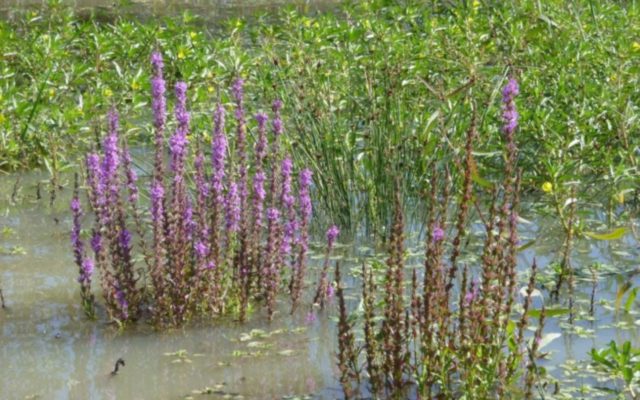
Loosestrife Blush can grow directly in water at a depth of 30 cm
Select a site 2 weeks before planting. To do this, you need to dig it up and level the surface. Then prepare a planting pit 40 by 40 cm in size.It must be filled by 2/3 of the volume with a mixture of turf, sand, peat, leafy earth, taken in the same amount. Additionally, add 30 g of superphosphate and 15 g of potassium sulfate, and then mix everything thoroughly.
Landing algorithm
The Blush loosestrife is planted according to the standard scheme. Therefore, it will not be difficult to complete the procedure, even for a gardener who does not have many years of experience.
Algorithm of actions when planting a Blush loosestrife:
- Water the planting hole abundantly.
- Place the seedling in the center, spread the roots.
- Sprinkle them with earth and carefully fill all the voids.
- Compact the soil at the base of the loosestrife.
- Water again.
Watering and feeding schedule
The loosestrife should be watered regularly, although the plant can tolerate drought. With a lack of moisture in the soil, the decorativeness of the culture decreases. Watering should be carried out once a week with the soil under the bush getting wet up to 20 cm.
Fertilize the plant in moderation. Therefore, at the beginning of the growing season in the spring, organic matter (chicken droppings 1:15) or urea should be used at the rate of 20 g per 10 liters of water.And during the formation of peduncles, 30 g of superphosphate and 15 g of potassium sulphide should be used for the same volume of water.
Weeding, loosening, mulching
Throughout the season, you need to remove weeds in the root circle so that they do not take nutrients from the seedling. It is also important to loosen the soil after each watering and rain to improve air access to the roots.
During hot periods in summer, cover the soil in the root circle with mulch. This will prevent excessive evaporation and overheating of the root system. For this, you can use humus, peat.
Pruning
Loosestrife Blush should be pruned once a year. The procedure should be carried out in the fall, cutting off the shoots at the base. But you can leave the dry branches of the plant to decorate the winter garden. Then pruning should be done in early spring, removing the aerial parts of the previous year.
Wintering
Loosestrider Blush does not need shelter for the winter. It is enough to sprinkle the plant with plenty of snow. In the case of snowless frosty winters, cover the perennial root with a thick layer of humus or peat mulch.
Pests and diseases
Loosestrife Blush has a high natural immunity. Until now, not a single case of damage to this plant by fungal and viral diseases has been recorded, which is one of its advantages.
Only aphids that move with a number of planted roses can cause damage to the loosestrife. Therefore, at the first signs of damage, it is necessary to treat the bush with the Actellik insecticide.
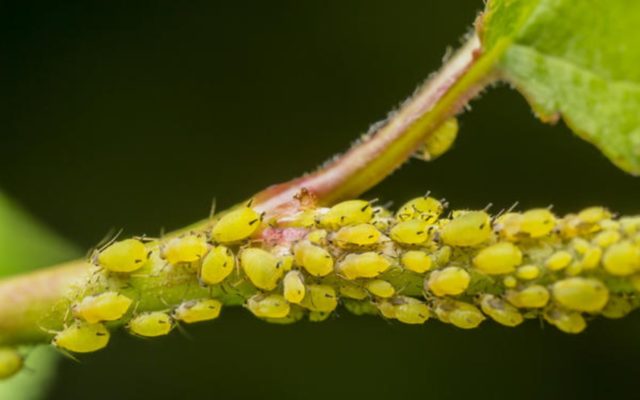
Aphids form entire colonies on the tops of the shoots
Conclusion
Loosestrife Blush is a flowering, unpretentious perennial, which, with minimal care, is able to grow and fully develop. The peculiarity of this culture is that it is distinguished by its high endurance, therefore, it is able to adapt and endure any climatic conditions. But when growing it, it should be borne in mind that this perennial is capable of capturing adjacent territories, therefore, these attempts should be suppressed in order to preserve the beauty of the composition.
